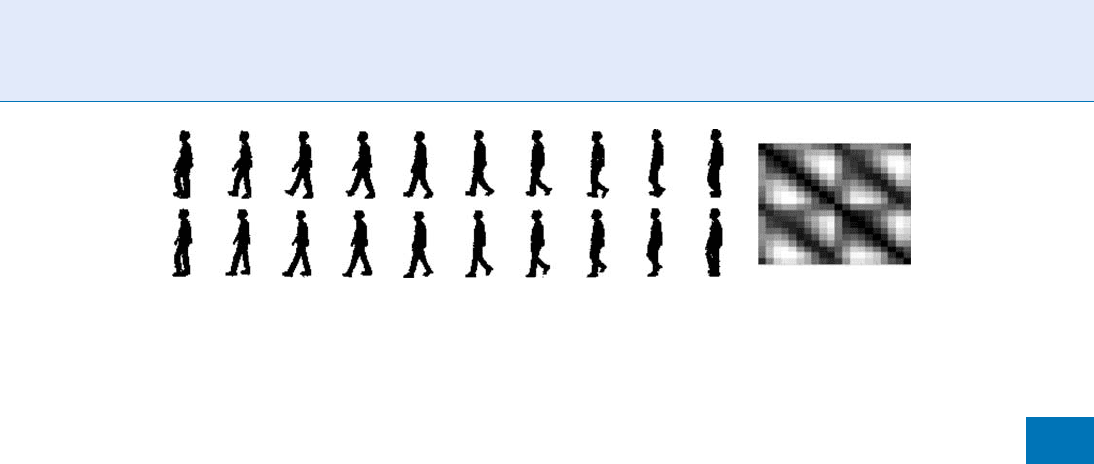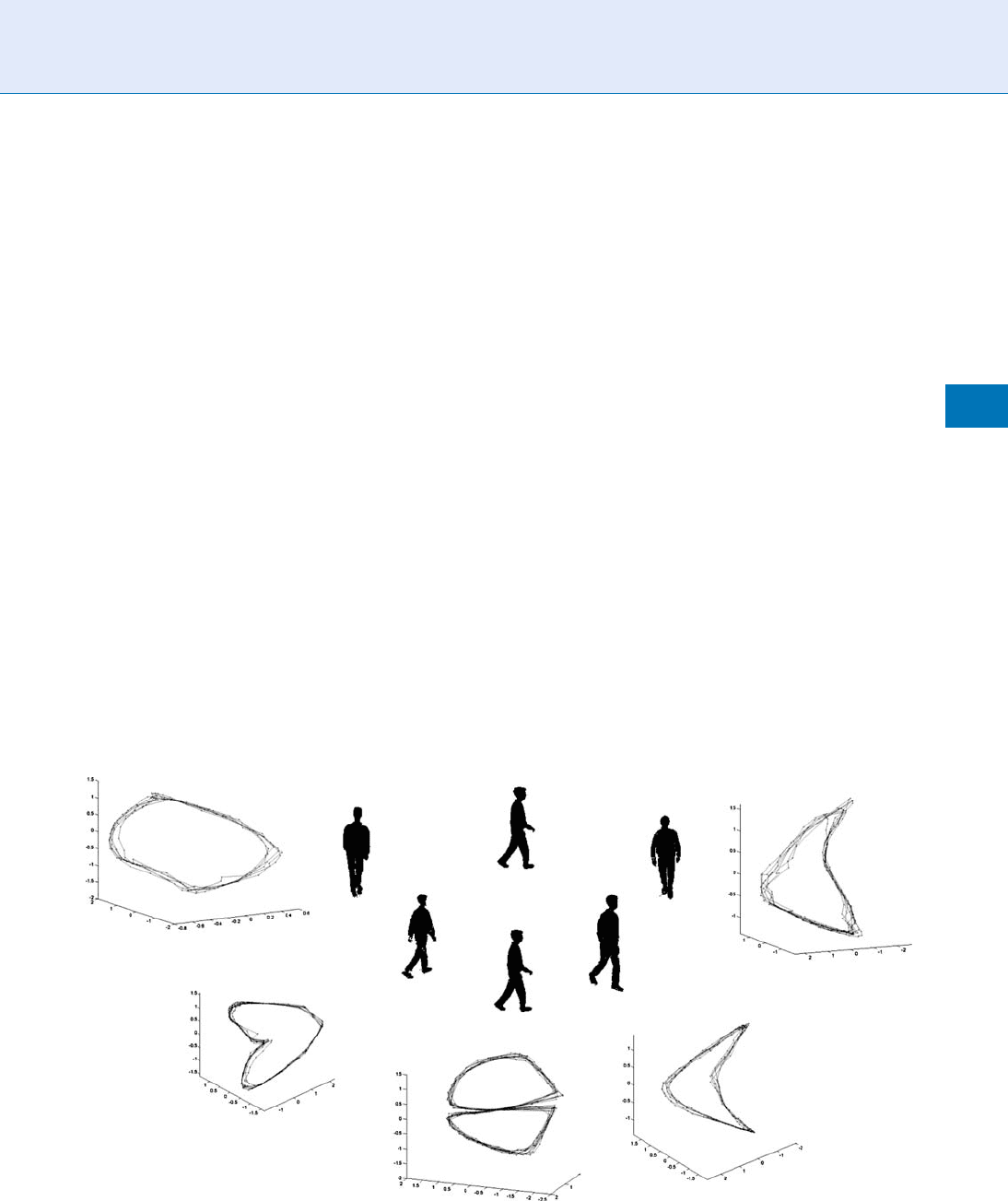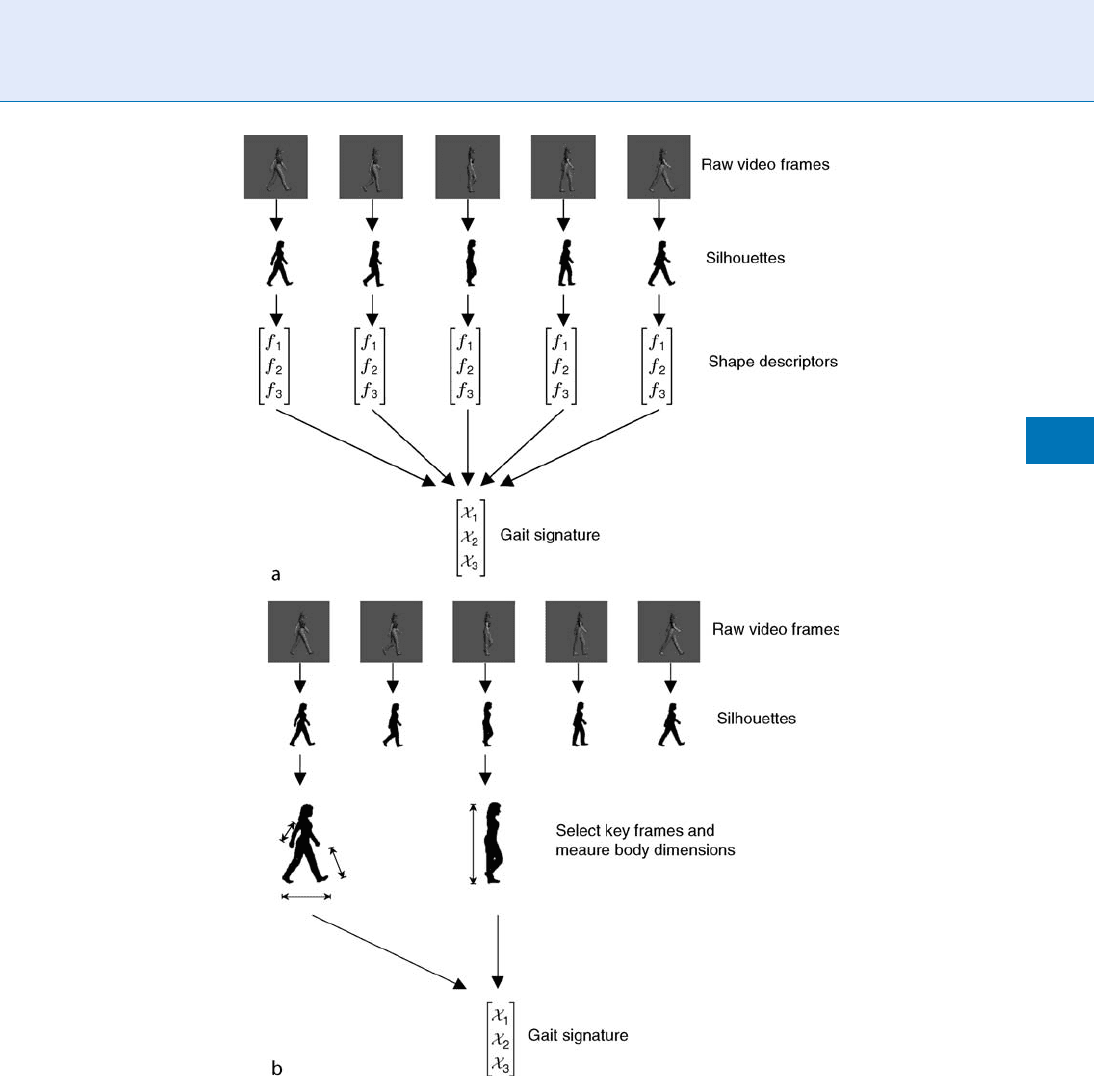Li S.Z., Jain A.K. (eds.) Encyclopedia of Biometrics
Подождите немного. Документ загружается.


body configuration and extracting biometrics very
challenging. Besides the articulation nature of the
body, the variability in people’s appearance adds to
the problems. Human gait is a special case of the
general problem of human motion analysis, and to
some extent, is easier. This is because of the physical
constraints on such a motion as well as the periodic
nature of it.
The appearance of gait in an image sequence is a
spatiotemporal process that characterizes the walker.
Gait recognition algorithms, generally, aim to capture
discriminative spatiotemporal features (signature)
from image sequences in order to achieve human
identification. Gait analysis approaches can be categor-
ized according to the way the gait features are extracted
for classification. There are two broad categories of
approaches: model-based approaches and appear-
ance-based approaches. Model-based approaches,
e.g., [1], fit 3D body models or intermediate body
representations to body limbs in order to extract prop-
er features (parameters) that describe the dynamics of
the gait (see the related entry on ‘‘Model-based Gait
Recognition’’ for details). Model-based approaches
typically require a large number of pixels on the
tracked target to fit their model, i.e., high resolution
zoomed-in images are required on the tracked person.
In contrast, appearance-based approaches aim to cap-
ture a spatiotemporal gait characteristic directly from
input sequences without fitting a body model. The
appearance-based approaches are mainly motivated
by the psychophysical experiments, mentioned earlier,
e.g., [3, 4], which showed that spatiotemporal patterns
such as Moving Light Displays could capture impor-
tant gait information without the need of finding
limbs. Appearance-based approaches do not require
high resolution on subjects, which makes them more
applicable in outdoor surveillance applications where
the subjects can be at a large distance from the camera.
Characteristics and Challenges of
Gait Motion
Gait is a 3D articulated periodic motion that is pro-
jected into 2D image sequences. Therefore, the appear-
ance of a gait motion in an image sequence is a
spatiotemporal pattern, i.e., a spatial distribution of
features that changes over time. Researchers have de-
veloped several algorithms for capturing gait signature
from such spatiotemporal patterns by looking at the
space-time volume of features. The observed shapes of
the human body, in terms of the occluding contours of
the body (silhouettes), are examples of such spatiotem-
poral patterns, which contain rich perceptual infor-
mation about the body configuration, the motion
performed, the person’s gender, the person’s identity,
and even the emotional states of the person. Objects
occluding contours, in general, have a great role in
perception [7] and have been traditionally used in
computational vision, besides other appearance cues,
to determine object categor y and pose.
The objective of any gait tracking and analysis
system is to track the global deformations of contours
over time and to capture invariant gait signature from
such contours. There are several challenges to achieve
this goal. An observed person’s contour in a given
image is a function of many factors, such as the per-
son’s body build (tall, short, big, small, etc.), the body
configuration, the person’s clothing and the viewpoint.
Such factors can be relevant or irrelevant depending on
the application. Modeling these sources of variabilities
is essential to achieve successful trackers and to extract
gait biometric features. Modeling the human body
dynamic shape space is hard, since both the dynamics
of shape (different postures) and the static variability
in different people’s shapes have to be considered. Such
shape space lies on a nonlinear
▶ manifold.
Figure 1 shows an example of a walking cycle from
a side view where each row shows half a walking cycle.
The shapes during a gait cycle temporally undergo
deformations and self-occlusion. The viewpoint from
which the gait is captured imposes self-similarity on
the observed shapes over time. This similarity can be
noticed by comparing the corresponding shapes at the
two rows in Fig. 1. This right part of the figure shows
the correlation between these shapes. The similarity
between the corresponding shapes in the two half
cycles is exhibi ted by the dark diagonally parallel
bands in the correlation plot. The similarity in the
observed shapes indicates a nonlinear relation between
the observed gait and the kinematics of the gait. This
can be noticed by closely inspecting the two shapes in
the middle of the two rows in Fig. 1. These two shapes
correspond to the farthest points in the walking cycle
kinematically (the top has the right leg in front
while the bottom has the left leg in front). In the
Euclidean visual input space (observed shapes) these
two points are very close to each other as can be
noticed from the distance plot on the right of Fig. 1.
This nonlinear relation between the observed shapes
640
G
Gait Recognition, Motion Analysis for

and the kinematics poses a problem to gait tracking
and analysis systems. However, such similarity can
be useful in extracting gait features. For example,
the temporal self-simil arity characteristic has been
exploited in the work of BenAbdelkader et al. [8] for
gait recognition.
Extracting Gait Signature from
Motion
There have been extensive research on appearance-
based extraction of gait signatures. Typical prepro-
cessing step s for gait analysis include detecting
and tracking the human subject in order to locate a
bounding box containing the moti on and/or extracting
the body silhouette (see the related entry on human
detection and tracking).
One of the early papers on gait analysis using
spatiotemporal features is the work of Niyogi and
Adelson [9] where a spatiotemporal pattern (corres-
ponding to leg motion) was used to detect gait motion
in an image sequence represented as an XYT volume.
Gait was then parameterized with four angles for rec-
ognition. Murase and Sakai [10] used a parametric
eigenspace representation to represent a moving object
using Principle Component Analysis (PCA). In their
work, the extracted silhouettes were projected into an
eigenspace where a walking cycle forms a closed trajec-
tory in that space. Spatiotemporal correlations be-
tween a given trajectory and a database of trajectories
were used to perform the recognition. Huang et al. [11]
extended the method using Canonical space transfor-
mation (CST) based on Canonical Anaylsis (CA), with
eigenspace transformation for feature extraction.
Little and Boyd [12] exploited the spatial distri-
bution of optical flow to extract spatiotemporal
features. From dense optical flow, they extracted
scale-independent features capturing the spatial distri-
bution of the flow using moments. This facilitates
capturing the spatial layout of the motion, or as they
call it ‘‘the shape of the motion.’’ Periodicity analysis was
then done on these features to capture gait signatures for
recognition. BenAbdelkader et al. [8] used image self-
similarity plots (similar to Fig. 1) to capture the spa-
tiotemporal characteristics of gait. Given bounding
boxes around a tracked subject, correlation is used to
measure self-similarity between different time frames
in the form of similarity plots. PCA analysis was used
to reduce the dimensionality of such similarity plots
for recognition. Hayfron-Acquah et al. [13] used spa-
tial symmetry information to capture gait chara-
cteristics from silhouettes. Given a walking cycle, a
symmetry operator was used to extract a symmetry
map for each silhouette instance in the cycle. Fourier
transform was used to extract descriptors from such
symmetry maps for recognition.
Since gait is a temporal sequence, researchers have
investigated the use of Hidden Markov Models
(HMM) to represent and capture gait motion charac-
teristics. HMMs have been successfully used in many
speech recognition systems, as well as gesture recogni-
tion applications. Typically a left-right HMM with a
small number of states (three to five) is sufficient to
model the gait of each subject in the database, where
the HMMs are trained from features extracted from
silhouettes. In [14], HMM was used to capture gait
dynamics from quantized Hu moments of silhouettes.
HMM was also used in [15] with features representing
silhouette width distribution.
Lee and Elgammal [16] used bilinear and multi-
linear models to factorize the spatiotemporal gait pro-
cess into gait style and gait content factors. A nonlinear
mapping was learned from a unit circle (representing a
gait cycle) to the silhouettes’ shap e space. The unit
circle represents a unified model for the gait manifold
Gait Recognition, Motion Analysis for. Figure 1 Twenty sample frames from a walking cycle from a side view. Each row
represents half a cycle. Notice the similarity between the two half cycles. The right part shows the similarity plot: each
row and column of the plot corresponds to one sample. Darker means closer distance and brighter means larger
distances. The two dark lines parallel to the diagonal show the similarity between the two half cycles.
Gait Recognition, Motion Analysis for
G
641
G

of different people, therefore, any spatiotemporal char-
acteristics of the gait of a specific person should exist
on the mapping space. Bilinear and multilinear models
were used to factorize such mapping to extract gait
signatures.
Manifold-based Representation for
Gait Analysis
Despite the high dimensionality of the human body
configuration space, any body motion is constrained
by the physical dynamics, body constraints, and the
motion type. Therefore, many human activities lie
intrinsically on low dimensional manifolds. This is
true for the body kinematic s, as well as for the observed
motion through image sequences. For certain classes of
motion like gait, facial expression, and simple gestures,
considering a single person and factoring out other
sources of variability, the deformations will lie on a
one-dimensional manifold. Recently many researchers
have developed techniques and representations for gait
analysis that exploit such manifold structure, whether
in the visual space or in the kinematic space, e.g.
[17, 18]. Modeling the gait manifold was earlier used
for gait recognition in [10].
Intuitively, the gait is a one -dimensional closed
manifold that is embedded in a high dimensional
visual space. Such a manifold can twist and self-inter-
sect in such high dimensional visual space. This can be
Gait Recognition, Motion Analysis for. Figure 2 Embedded gait manifold for a side view of the walker. Left: sample
frames from a walking cycle along the manifold with the frame numbers shown to indicate the order. Ten walking cycles
are shown. Right: three different views of the manifold. ß IEEE.
642
G
Gait Recognition, Motion Analysis for

noticed by considering the human silhouette through
the walking cycle, (as shown in Fig. 1) as points in a
high dimensional visual input space. Given the spatial
and the temporal constraints, it is expected that these
points will lay on a closed trajectory. In order to
achieve a low dimensional embedding of the gait man-
ifold (
▶ manifold embedding), dimensionality reduc-
tion techniques can be used. Linear dimensionality
reduction can be used to achieve an embedding, as in
[10]. However, in such a case the two half cycles would
be collapsed to each other because of the similarity in
the shape space. Nonlinear dimensionality reduction
techniques such as LLE [19], Isomap [20], GPLVM
[21], and others can successfully embed the gait
▶ manifold in a way that separates the two half cycles.
As a result of nonlinear dimensionality reduction, an
embedding (and a visualization) of the gait manifold
can be obtained in a low-dimensional Euclidean
space [17]. Figure 2 illustrate s an example embedded
manifold for a side view of the walker. The data used
are from the CMU Mobo gait data set which contains
25 people from six different view points. Data sets
of walking people from multiple views are used in
this experiment. Each data set consists of 300 frames
and each containing about 8–11 walking cycles of
the same person from a certain view points. The
walkers were using treadmill which might result in
different dynamics from the natural walking. Figure 3
illustrates the embedded manifolds for five different
view points of the walker. For a given view point, the
walking cycle evolves along a closed curve in the
embedded space, i.e., only one degree of freedom con-
trols the walking cycle, which corresponds to the
constrained body pose as a function of the time.
Such a conclusion conforms to the intuition that the
gait manifold is one-dimensional.
As can be noticed in Fig. 3, The manifold twists in
the embedding space given the different viewpoints ,
which impose different self occlusions. The least twist-
ed manifold is the manifold for the back view as this
is the least self occluding view (left most manifold in
Fig. 3. In this case the manifold can be embedded in
a two dimensional space. For other views, the curve
starts to twist to be a three-dimensional space curve.
This is primarily because of the similarity imposed by
the view point which attracts far away points on the
manifold closer. The ultimate twist happens in the
side view manifold where the curve twists to get
the shape of the numeral 8 where each cycle of the
eight (half eight) lies in a different plane. Each half of
the ‘‘eight’’ figure corresponds to half a walking cycle.
The cross point represents the body pose where it is
Gait Recognition, Motion Analysis for. Figure 3 Embedded manifolds for five different views of the walkers. Frontal
view manifold is the right most one and back view manifold is the leftmost one. The view of the manifold that best
illustrates its shape in the 3D embedding space is visualized. ß IEEE.
Gait Recognition, Motion Analysis for
G
643
G

totally ambiguous from the side view to determine
from the shape of the contour which leg is in front,
as can be noticed in Fig. 2. Therefore, in a side view, a
three-dimensional embedding space is the least that
can be used to discriminate the different body poses.
Embedding a side view cycle in a two-dimensional
embedding space results in an embedding similar to
that shown in top right of Fig. 2 where the two half
cycles lie over each other . Inter estingly, despite that
the side view is the most problematic view of the gait,
most gait recognition systems seem to favor such view
for recognition! Different people are expected to have
different manifolds. However, such manifolds are all
topologically equivalent.
The example embeddings shown here are for sil-
houette data, i.e., the visual manifold of the gait is
Gait Recognition, Motion Analysis for. Figure 4 Adaptive Contour Tracking of Gait: (a) tracking through sample
frames. (b) adapting to the target style. (c) the tracked body configuration showing a constant speed dynamic system.
From [22].
644
G
Gait Recognition, Motion Analysis for

embedd ed. Simil ar embedd ing can be obtai ned for
kinem atic data, in such a case the kin ematic manifo ld
of the gait is embedde d. In suc h a case PCA would be
suffic ient to achieve an em bedding . The impor tance of
such em bedded representat ions is that they prov ide a
low dimension al representation for tracki ng the gait
motion. On ly a one-dime nsional paramet er is nee ded
to control and track the gait moti on. This leads to a
simple constant speed dynam ic model for the gait .
Figure 4 shows an examp le of gait contour tr acking
system [22 ] that uses an embedded re pre sentation o f
the gait manifold. As a result, a constant speed linear
dynamics is achieved (Fig . 4b). The tracke r can a lso
adapt t o t he tracke d person shape st yle a nd identify
that st yle fro m a database of st yles ( Fig . 4c).
Explicit manifol d representation for gait is not only
useful for tracking and pose estimati on, but also can be
used in gait recognition sy stems. Different people are
expecte d to have different manifol ds for the appear-
ance of their gait. However, such manifol ds are all
topolo gically equivalen t to a unit circle. A person’s
gait manifol d can be tho ug ht of as a tw iste d circle in
the input space. The spati otemporal process of gait is
captured in the tw ist of a given per son’s manifol d.
Therefore, a per son’s gait signature can be captu red
by mode ling how a unit circle (an ideal manifol d)
can def orm to fit that per son’s gait manifol d. This
can be achieved by fitting a nonlinear war ping functio n
between a unit circle and a given person’s silhouet te
sequen ce. In [23 ] this approach was used to capture
gait si gnatures by factor izing the w arping func tions’
coefficient space to obtain a low -dimensi onal gait sig-
nature space for recogni tion.
Summary
Appearance-b ased ana lysis of gait is motivat ed and
justifi ed by psychophysical exp erimen ts. Appearance-
based app roaches fo r gait recognition aim to extrac t a
gait signatu re from the spati al and tempora l distri bu-
tion of the features on a tr acked subjec t w ithout the
need to fit a body model or to locate limb s. Such
approaches have proved ver y successful in gait recog-
nition and are applicab le in scenarios where the gait
biome tric features can onl y be extra cted from a
dista nce. The re are many limitatio ns to the current
gait recognition system s incl uding achiev ing invaria nt
to v iew ing condi tions, such as v iew point invariant.
Recent progress in manifol d-based representation of
gait, as well as facto rized models, such as mu ltilinear
tensor models prov ides potential solutio ns to such
problems.
Related Entries
▶ Gait Recognition, Model-B ased
▶ Human detectio n and tra cking
References
1. Cunado D., Nixon M.S., Cart er J.: Automatic extraction and
description of human gait models for recognition purposes.
Compt. Vision Image Understand. 90 , 1–41 (2003)
2. Sarkar S., Phillips P.J., Liu Z., Vega I.R., Grother P., Bowyer K.W.:
The humanid gait challenge problem: Data sets, performance,
and analysis. IEEE Trans. PAMI 27 (2), 162–177 (2005)
3. Johansson G.: Visual motion perception. Sci. Am. 232, 76–88
(1975)
4. Cutting J.E., Kozlowski L.T.: Recognizing friends by their walk:
gait perception without familiarity cues. Bull. Psychonomic Soc.
9(5), 353–356 (1977)
5. Gavrila D.M.: The visual analysis of human movement: a survey.
Comput. Vis. Image Understand. 73(1), 82–98 (1999). DOI
http://dx.doi.org/10.1006/cv iu.1998.0716
6. Moeslund T.B., Hilton A., Kru
¨
ger V.: A survey of advances in
vision-based human motion capture and analysis. Comput. Vis.
Image Underst. 104(2), 90 –126 (2006). DOI http://dx.doi.org/
10.1016/j.cviu.2006.08.002
7. Palmer, S.E.: Vision Science, Photons to Phenomenology. MIT,
Cambridge, MA (1999)
8. BenAdbelkader, C., Cutler, R., Davis, L.: Motion-based recogni-
tion of people using image self-similarity. In: Proceedings of the
Fifth IEEE International Conference on Automatic Face and
Gesture Recognition, pp. 254–259 (2002)
9. Niyogi, S., Adelson, E.: Analyzing and recognition walking fig-
ures in xyt. In: Proceedings of IEEE CVPR, pp. 469–474 (1994)
10. Murase H., Sakai R.: Moving object recognition in eigenspace
representation: gait analysisand lip reading. Pattern Recog. Lett.
17, 155–162 (1996)
11. Huang P., Haris C., Nixon, M.: Recogising humans by gait via
parametric canonical space. Artif. Intell. Eng. 13, 359–366 (1999)
12. Little, J.J., Boyd, J.E.: Recognizing people by their gait: The shape
of motion. Videre: J. Comput. Vision Res. 1(2) (1998)
13. Hayfron-Aquah J.B., Nixon M.S., Carter J.N.: Automatic gait
recognition by symmetry analysis. Pattern Recogn. Lett. 24,
2175–2183 (2003)
14. He, Q., Debrunner, C.: Individual recognition from periodic
activity using hidden markov models. In Proceedings of the
Workshop on Human Motion (Humo) (Dec, 2007). HUMO.
IEEE Computer Society, Washington, DC
15. Kale, A., Sundaresan, A., Rajagopalan, A.N., Cuntoor, N.P.,
Roy-Chowdhury, A.K., Kruger, V., Chellappa, R.: Identification
Gait Recognition, Motion Analysis for
G
645
G

of human using gait. IEEE Trans. Image Process. 13(9),
1163–1173 (2004)
16. Lee, C.S., Elgammal, A.: Gait style and gait content: Bilinear
model for gait recogntion using gait re-sampling. In: Proceed-
ings of FGR, pp. 147–152 (2004)
17. Elgammal, A., Lee, C.S.: Inferring 3d body pose from silhouettes
using activity manifold learning. In: Proceeedings of CVPR,
vol. 2, pp. 681–688 (2004)
18. Urtasun, R., Fleet, D.J., Hertzmann, A., Fua, P.: Priors for people
tracking from small training sets. In: ICCV, Beijing, China
pp. 403–410 (2005)
19. Roweis S., Saul L.: Nonlinear dimensionality reduction by locally
linar embedding. Science 290(5500), 2323–2326 (2000)
20. Tenenbaum, J.: Mapping a manifold of perceptual observations.
In: Proceedings of Advances in Neural Information Processing
(NIPS), vol. 10, pp. 682–688 (1998)
21. Lawrence, N.D.: Gaussian process models for visualisation of
high dimensional data. In: Proceedings of NIPS. BMVC, Oxford,
UK (2004)
22. Lee, C.S., Elgammal, A.: Style adaptive bayesian tracking using
explicit manifold learning. In: Proceedings of British Machine
Vision Conference (2005)
23. Lee, C.S., Elgammal, A.: Audio- and Video-based Biometric
Person Authentication Conference AVBPA. Terrytown, NY,
USA (2005)
Gait Recognition, Silhouette-Based
JEFFREY E. BOYD
1
,JAMES J. LITTLE
2
1
University of Calgary, Calgary, AB, Canada
2
University of British Co lumbia, Vancouver, BC,
Canada
Definition
Silhouette-based gait recognition is the analysis of
walking human figures for the purpose of biometric
recognition. Gait biometrics offers the advantage
of covertness; acquisition is possible without the
awareness or cooperation of the subject. The analysis
may apply to a single static image, or to a temporal
sequence of images, i.e., video.
Introduction
The phenomenon of gait is the ‘‘coordinated, cyclic
combination of movements that result in human loco-
motion’’ [1]. Gait is necessary for human mobility and
is therefore ubiquitous and easy to observe.
The common experience of recognizing a friend
from a distance by the way they walk has inspired
the use of gait as a biometric feature. In fact, Cutting
and Kozlowski [ 2], using
▶ moving light displays
to isolate the motion stimulus, demonstrated that
humans can indeed identify familiar people from gait.
In their experiments, seven subjects identified the
gaits of a subset of six subjects correctly at a rate of
38%. While this rate is less than adequate for bio-
metrics, it is significantly better than random (17% in
for their sample size), and validates the human source of
inspiration.
To convert a gait into a feature vector suitable for
biometrics, one can characterize the motion in the gait,
e.g., by analyzing joint angles and limb trajectories, or
by measuring the overall pattern of motion. Alterna-
tively, one can measure critical body dimensions such as
height or limb lengths. In the later approach, biometric
features can be measured statically, but the motion in
the gait provides a convenient mechanism to reveal
joint positions, and consequently, limb lengths.
McGeer’s work on passive dynamic walkers [3, 4]
reveals the extent to which gait motion relates to
body mass and limb lengths: in the passive dynamic
model of a human gait, the motion is a stable limit
cycle that is a direct result of body mass and limb
length. Factors not accounted for in McGeer’s original
model are muscle activation (grav ity powers a passive
dynamic walker), walking surface, injury, and fatigue.
Intuitively, the motion in a gait is a reflection of the
mass and skeletal dimensions of the walker. McGeer’s
passive dynamic model leads to more sophisticated
models that account for some of these other factors.
For example, see the work of Kuo [5, 6].
Confounding factors in gait biometrics include
clothing and footwear. Clothing can change the
observed pattern of motion and make it difficult to
accurately locate joint positions. The effect of footwear
is more complex. Some variation in footwear causes
changes in muscle activation, but causes no outwardly
visible change in the pattern of motion [7], whereas
other footwear changes will alter gait.
▶ Silhouette-based gait recognition extracts the
form of a walking subject, and then computes a feature
vector that describes either the pattern of motion
in the gait, or the physical dimensions of the subject.
A class ifier then matches the feature vector against
previously acquired examples for identification or
verification.
646
G
Gait Recognition, Silhouette-Based

Silhouettes
Definitions of silhouette are often ambiguous: some
definitions refer to the region covered by a figure,
whereas other definitions refer to the boundary be-
tween a figure and its background. In the context of
silhouette-based gait biometrics, we assume that the
silhouette refers to the region, rather than the border.
Nevertheless, there are related examples that use the
boundary, e.g., see Baumberg and Hogg [8].
To form a silhouette of a walking figure requires
the
▶ segmentation of image pixels into foreground
(the moving figure) and background (everything else)
sets of pixels. The silhouette is the set of foreground
pixels. The easiest way to acquire a reliable silhouette is
chroma-keying [9], which relies on color disparities
between a backdrop and the foreground subject. The
background color (usually green or blue), is chosen to
make the color discrimination robust. Figure 2d shows
an example of chroma-keying in gait analysis. The
unusual color of the backdrop makes the subject
aware that they are under surveillance, negating the
covertness of gait biometrics.
▶ Background subtraction obviates the need for a
colored backdrop by measuring the naturally occur-
ring scene behind the subject. This entails estimating
the statistical properties (usually in the luminance
and color) of every pixel over one or more frames
of video. By comparing the background estimate
with subsequent frames of video, one can classify fore-
ground pixels as those that do not match the back-
ground. The classifier can be as simp le as thresholding
of the absolute difference between the background and
video frames. In most cases, the background esti ma-
tion and subtraction are merged into an online system
that continuously computes pixel differences and then
updates the background for each frame of video. Back-
ground subtraction requires that the background
and camera be stationary. Stauffer and Grimson [10]
describe a widely used background subtraction method
that uses a multimodal estimate of background stat is-
tics to produce reliable silhouettes of moving objects.
Their method is robust in the presence of some back-
ground motions (e.g., rustling leaves or swaying tree
branches).
The projection of motion in a scene onto a camera
image plane is called a motion field. When a human
figure is walking, segmenting moving from slow or
stationary pixels in the motion field will extract a
silhouette of the figure. Additionally, a motion field
provides richer information than a simple silhouette
because it indicates not only where the subject is moving,
but also how fast the various body parts are moving. In
general, it is not possible to measure a motion field, but
one can measure
▶ optical flow, an approximation to
the motion field that is sufficient for biometric gait
recognition. If one imagines the luminance of pixels to
be a fluid that can flow around an image, the optical
flow estimates the movement of that fluid. It is, in part,
related to the motion field, but is not necessarily equal to
the motion field in all cases. Barron et al. [11] provide a
comparative survey of some well-known optical flow
algorithms. For example, see Fig. 2a.
Most silhouette-based biometr ic gait analysis
focuses on a view of the subject orthogonal to the
sagittal plane of the subject, i.e., the subject walks
across the field of view rather than toward or away
from the camera. We believe that this preference exists
because front or rear views of the subject show mostly
side-to-side motion and do not reveal either joint
location or the complex patterns of limb motion.
Marker-based motion capture, e.g., Johansson’s
moving light displays, offers a counterpoint to silhou-
ettes that are less practical for biometrics, but are
useful for gaining insight into the perceptual issues
surrounding gait [12, 13].
Duration of Observation
In general, it is desirable to observe the gait as long as
possible. One way to extend the duration of an obser-
vation indefinitely is to have a subject walk on a tread-
mill in front of a stationary camera, e.g., see Fig. 2b.
However, this requires the cooperation and awareness
of the subject.
Alternatively, allowing the camera to pan with the
motion of the subject can extend the observation time
without the subject walking on a special apparatus.
However, when the camera moves, the images acquired
contain both the movement of the subject, and the
background. The changing background makes accu-
rate background subtraction difficult.
Using a static camera simplifies both the apparatus
and the processing to extract the silhouette, but the
duration of observation is limited by the time it takes
the subject to cross the field of view of the camera. The
actual duration will vary with the angular width of
Gait Recognition, Silhouette-Based
G
647
G

the field of view, the distance between the subject
and the camera, and the speed of the subject. The
practical limit on distance to subject depends on the
resolution of the camera. Higher resolutions allow
the subject to be further away while maintaining
enough pixel coverage to measure biometric feature
vectors accurately. In examples reported in the litera-
ture that use a static cameras and subjects walking on
the ground, the typical duration of observation is
approximately three to six strides.
Periodicity and Synchronization
Gait is a periodic phenomenon, so the silhouette of a
walker varies with position in the gait cycle. Conse-
quently, it is necessary to synchronize measurements of
the silhouette to positions in the gait cycle. In turn, this
requires measurement of the frequency of the gait and
establishment of a phase reference within the gait cycle.
The method used to perform the synchronization
depends on the particular measurements acquired and
can serve to differentiate gait analysis methods. For
example, Little and Boyd [14] measure the frequency
from the oscillations of the centroid of the figure.
To establish a phase reference, they use the phase of
an oscillating measurement. In methods that measure
height, e.g., Ben-Abdelkader et al. [15], the frequency
of oscillations of the figure height gives the frequen-
cy of the gait. Positions of maxima in the height corre-
spond to the positions in the gait where the swinging
leg is vertical, thus defining a phase reference.
Conversion of Silhouettes to Features
A necessary step in silhouette-based gait recognition is
conversion of a temporal sequence of silhouettes into a
gait signature, i.e., a feature vector suitable for classifi-
cation. One approach is to extract features that char-
acterize the silhouette shapes and their variation over
time, as illustrated schematically in Fig. 1a.
As an example, Little and Boyd [14] use geometric
moments to describe a silhouette within a single frame
of video. The moments include geometric centers, i.e.,
the average position of pixels in the silhouette, some-
times called the center of mass. Weighting the pixel
positions by corresponding optical flow values gives
geometric moments sensitive to rapid limb movement.
Little and Boyd also use eccentricity [16], based on
higher-order geometrical moments. A further step is
necessary to combine the shape description for silhou-
ettes in individual frames to a feature vector repre-
sentative of the entire gait. Cyclic oscillations in the
silhouette shape moments result naturally from a gait,
so Little and Boyd exploit this to collect the individual
shape descriptions into a single feature vector of the
relative phases of the moment oscillations. Shutler and
Nixon [17] describe a variation on this approach that
uses Zernike moments to represent an accumulated
shape over the duration of a gait cycle.
Ben-Abdelkader et al. [18] also exploit the periodic
nature of a gait to form feature vectors. Periodicity and
symmetry in a gait mean that similar shapes occur
throughout the cycle of a gait. A feature vector built
from measures of the silhouette self-similarity over
period forms the basis for gait recognition. Periodicity
in the self-similarity measures establishes the frequency
of the gait. Hayfron-Acquah et al. [19] characterize the
silhouette shape in a single frame by measuring sym-
metries in the outline of the silhouette to produce a
symmetry map. The average of these symmetry maps
over a gait cycle gives the gait signature used for recog-
nition. Boyd [20] uses an array of phase-locked loops
to measure the frequency, amplitude, and phase of
pixel intensity oscillations due to a gait. The ampli-
tudes and relative phases form a vector of complex
phasors that acts as gait signature for recognition.
Rather than relying on the connection between gait
and body structure to form a gait signature, one can
use feature vectors that relate directly to body dimen -
sions as shown in Fig. 1b. For example, Bobick and
Johnson [21] measure stride and torso lengths, and
Ben-Abdelkader et al. [15] me asure heig ht and stride
characteristics. Collins et al. [22] identify key frames
in a gait sequence for both the double-support (two
feet on the ground) and mid-stride phase of a gait.
From these key frames they measure cues related to
height, width, and other body proportions, and move-
ment-related characteristics such as stride length, and
amount of arm swing.
Data Sets
A database of sample gaits is essential for developing a
silhouette-based gait recognition system. Little and
Boyd [14] provided one of the earliest databases
648
G
Gait Recognition, Silhouette-Based

featuring seven sample gaits for each of six subjects, for
a total of 42 gait sequences (Fig. 2a).
Gross and Shi [23] created the Motion of Body
(MOBO) database (Fig. 2b). It features gait samples
for 25 subjects. Each subject walks on a treadmill under
four different conditions (slow, fast, on an incline, and
carrying a ball) and from a variety of viewing angles.
Segmented silhouettes are part of the database.
Sarkar et al. [24] present a large (1.2 Gigabytes) gait
database as part of the HumanID Gait Challenge Prob-
lem associated with the Defense Advanced Research
Projects Agency (DARPA) HumanID project (Fig. 2c).
Gait Recognition, Silhouette-Based. Figure 1 Themes in silhouette-based gait recognition: (a) shape descriptors of
the silhouette combine to form a gait signature from the motion of the gait, or (b) critical body dimensions are measured
from key frames within the gait cycle. Existing methods use variations on both of these themes and can even
combine them.
Gait Recognition, Silhouette-Based
G
649
G
